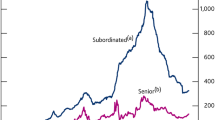Summary
This paper is based on the assumption that, in addition to its normal actuarial function, the contingency reserve of an insurance company can be regarded as an instrument of managerial risk policy and therefore can be applied accordingly. Parameters for decision are the amount of the reserve itself and the factors influencing it such as the distribution of the losses, desired degree of security, net premium, etc. The question of an optimal reserve policy has lead to the construction of a business decision model in Chapter I, which provides assumptions and the frame for dealing with the problem by actuarial methods.
The basis is the model of a Markoff decision process as described in Chapter II; the development of the reserve is shown therein as a Markoff decision process that can be influenced by various factors. Methods of organizational system research, making allowance for given factors of influence, can be used for the actuarial determination of an optimal reserve policy. These methods are applied to three pertinent sets of assumptions about the parameters influencing the amount of the reserve, viz. the monopoly position of the insurer (Chapter III), complete competition (Chapter IV) and a monopoly position in which the stochastic character of the reserve is taken into account ro a larger extent (Chapter V).
Similar content being viewed by others
Literaturverzeichnis
Ammeter, H.: über die risikotheoretischen Grenzen der Versicherbarkeit. BlÄtter der Deutschen Gesellschaft für Versicherungsmathematik (DGVM) Bd. II, Heft 3, 1955, S. 261 bis 277.
Ammeter, H.: Die Ermittlung der Risikogewinne im Versicherungswesen auf risikotheoretischer Grundlage. Mitteilungen der Vereinigung schweizerischer Versicherungsmathematiker (MVSV) Bd. 57, 1957, S. 145–200.
Anderson, T. W.;Goodman, L. A.: Statistical Inference About Markov Chains. Ann, Math. Stat. 28, 1957, S. 89–109.
Bhat, B. R.: Bayes Solution of Sequential Decision Problem for Markov Dependent Observations. Ann. Math. Stat. 35, 1964, S. 1656–1662.
Bellman, R.: Dynamic Programming, Princeton Univ. Press 1957.
Burger, E.: Einführung in die Theorie der Spiele. De Gruyter, Berlin 1959.
Campagne, C.: Sur les événements en chaÎne et la distribution binomiale négative généralisée. The Astin Bulletin (AB) Bd. 2 II, 1962, S. 222–240.
Chernoff, H.;Moses, L. E.: Elementary Decision Theory. J. Wiley, New York 1959.
Cramér, H.: Collective risk theory. The Jubilee Volume of P. Skandia 1955, Stockholm 1955.
Franckx, E.: Introduction à une théorie opérationeile du risque. MVSV Bd. 65, 1965, S. 197 bis 200.
Franckx, E.: Introduction à une théorie opérationelle du risque; 2e note la structure commune. MVSV Bd. 67, 1967, S. 87–97.
Heinen, E.: Das Zielsystem der Unternehmung. Gabler-Verlag, Wiesbaden 1966.
HollÄnder, H.: Ein Verfahren zur Bemessung der Maximalschwankungsrückstellung und der Zuführung zur Schwankungsrückstellung der Versicherungsunternehmen. BlÄtter der DGVM Bd. VII, Heft 2, 1965, S. 233–268.
Howard, R. A.: Dynamische Programmierung und Markoff-Prozesse. Industrielle Organisation, Zürich 1965.
Karten, W.: Grundlagen eines risikogerechten Schwankungsfonds für Versicherungsunternehmen. Duncker u. Humblot, Berlin 1966.
Kaufmann, A.: Graphs, Dynamic Programming and Finite Games. Mathematics in Science and Engineering, New York 1967.
Kemeny, J. O.;Snell, J. L.: Finite Markov Chains, van Nostrand Comp. Princeton 1960.
Klinger, H.: über die Verteilung des Ruinzeitpunktes bei beschrÄnkter Risikoreserve. BlÄtter der DGVM Bd. VII, Heft 2, 1965, S. 389–407.
Knopp, K.: Theorie und Anwendung der unendlichen Reihen. Springer, Berlin 1964.
Kupper, H.: Wahrscheinlichkeitstheoretische Modelle in der Schadenversicherung. BlÄtter der DGVM Bd. V, Heft 4, 1962, S. 451–503; Bd. VI, Heft 1, S. 95-130.
Luce;Raiffa, H.: Games and Decisions. J. Wiley, New York 1957.
Martin, J. J.: Bayesion Decision Problems and Markov Chains. J. Wiley, New York 1967.
Neumann, J. v.;Morgenstern, O.: Spieltheorie und wirtschaftliches Verhalten. Physica-Verlag, Würzburg 1964.
Shapley, L. S.: Stochastic Games. Proc. Nat. Acad. Sci. 39, 1953, S. 1095–1100.
Wolff, K. H.: Die Kapitalverzinsung in der Kollektiven Risikotheorie. SA Jg. 42, 1959.
Zachrisson, L.E.: Markov Games in: Advances in Game Theory. Ann. Math. Studies 52, 1964, S. 211–253.
Zurmühl, R.: Matrizen. Springer, Berlin 1958.
Author information
Authors and Affiliations
Rights and permissions
About this article
Cite this article
Heubeck, K. Optimale Reservepolitik als Markoffscher Entscheidungsproze\. Blätter DGVFM 10, 59–97 (1971). https://doi.org/10.1007/BF02808688
Received:
Issue Date:
DOI: https://doi.org/10.1007/BF02808688




